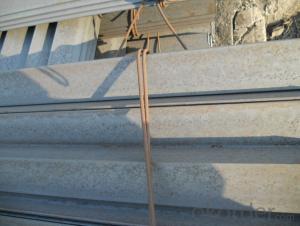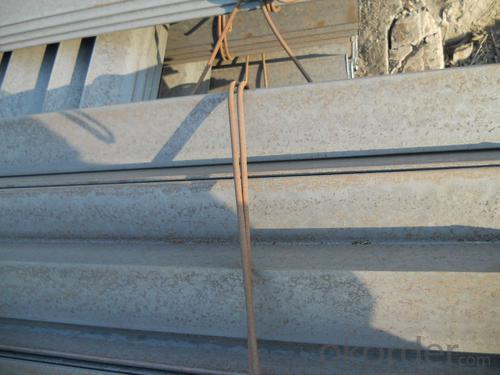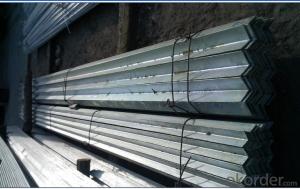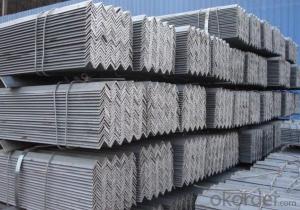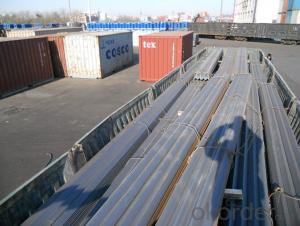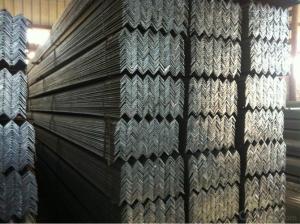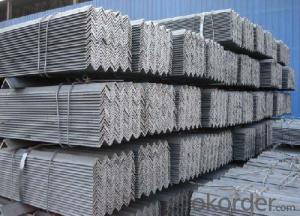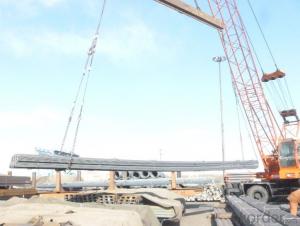Equal Steel Angle with High Quality and Competitive Price
- Loading Port:
- Tianjin
- Payment Terms:
- TT OR LC
- Min Order Qty:
- 25 m.t.
- Supply Capability:
- 20000 m.t./month
OKorder Service Pledge
OKorder Financial Service
You Might Also Like
Specification
Product Description:
OKorder is offering Equal Steel Angle with High Quality and Competitive Price at great prices with worldwide shipping. Our supplier is a world-class manufacturer of steel, with our products utilized the world over. OKorder annually supplies products to European, North American and Asian markets. We provide quotations within 24 hours of receiving an inquiry and guarantee competitive prices.
Product Applications:
Steel Angle Equal Angle with High Quality for Construction are ideal for structural applications and are widely used in the construction of buildings and bridges, and the manufacturing, petrochemical, and transportation industries.
Product Advantages:
OKorder's Steel Angle Equal Angle with High Quality for Construction are durable, strong, and resist corrosion.
Main Product Features:
· Premium quality
· Prompt delivery & seaworthy packing (30 days after receiving deposit)
· Corrosion resistance
· Can be recycled and reused
· Mill test certification
· Professional Service
· Competitive pricing
Packaging & Delivery of Steel Angle Equal Angle with High Quality for Construction:
Packaging Detail: products are packed in bundle and then shipped by container or bulk vessel, deformed bar is usually naked strapping delivery, when storing, please pay attention to moisture proof. The performance of rust will produce adverse effect.
Each bundle weight: 2-3MT, or as required
Payment term: TT or L/C
Delivery Detail: within 45 days after received advanced payment or LC.
Label: to be specified by customer, generally, each bundle has 1-2 labels
Trade terms: FOB, CFR, CIF

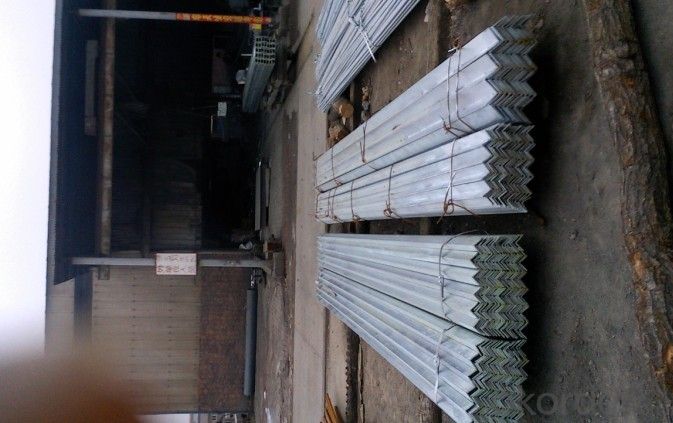
- Q: What are the considerations for selecting the appropriate steel angle finish?
- Several factors need to be taken into account when choosing the right steel angle finish. Firstly, the intended use or application of the steel angle is a primary consideration. Different finishes offer varying levels of corrosion resistance, which is crucial in environments with moisture or chemicals. For outdoor applications or high humidity environments, a hot-dip galvanized finish is often preferred due to its excellent corrosion resistance. Conversely, a plain steel finish may suffice for indoor applications where corrosion resistance is not a major concern. The desired aesthetic appearance is another consideration. Steel angles can be finished in different ways to achieve various looks. A mill finish provides a raw, industrial appearance, while a powder coat finish offers a polished look and a wide range of color options. The choice of finish depends on the desired aesthetic effect and the overall project design. Durability is also an important factor to consider. Finishes like zinc plating or stainless steel offer enhanced durability and resistance to wear and tear, making them suitable for heavy-duty applications or high-traffic areas. On the other hand, a painted finish may be more prone to chipping or scratching, making it less suitable for long-term durability requirements. Lastly, cost plays a significant role in the decision-making process. Different finishes have varying costs associated with them, so it is necessary to balance the desired finish with the available budget. It is worth noting that while certain finishes may have a higher upfront cost, they may provide long-term cost savings by reducing maintenance or replacement needs. To summarize, the appropriate steel angle finish selection depends on factors such as corrosion resistance, aesthetic appearance, durability requirements, and budget considerations. By carefully evaluating these factors, one can choose the most suitable finish that meets both functional and aesthetic needs.
- Q: How do you prevent galvanic corrosion in steel angles?
- There are several measures that can be taken to prevent galvanic corrosion in steel angles. 1. Utilizing a proper coating, such as paint, epoxy, or galvanization, can establish a barrier between the steel angle and other metals. This creates a separation, reducing the chance of galvanic corrosion. 2. Insulation materials, like rubber or plastic washers, gaskets, or sleeves, can be employed to isolate the steel angle from other metals. This prevents the flow of electrical currents and decreases the likelihood of galvanic corrosion. 3. It is crucial to consider the compatibility of different metals when designing structures or systems involving steel angles. Pairing metals with similar electrochemical properties can minimize the risk of galvanic corrosion. 4. Regular maintenance is essential in identifying and addressing early signs of galvanic corrosion in steel angles. This includes inspecting the protective coating for any damage, ensuring proper insulation, and applying appropriate remedies if corrosion is detected. By incorporating these preventive measures, the risk of galvanic corrosion in steel angles can be significantly reduced, guaranteeing their durability and structural integrity.
- Q: What are the typical uses for steel angles?
- Steel angles have a wide range of uses in various industries and construction projects. One of the most common applications is in structural framing, where steel angles are used to provide additional strength and support to buildings and other structures. They are often used to create bracing, reinforcing, and framing elements in construction projects, such as beams, columns, and trusses. Another typical use for steel angles is in manufacturing and fabrication. They are utilized in the production of machinery, equipment, and vehicles, where their ability to withstand heavy loads and resist bending or warping makes them an ideal choice. Steel angles can be used as frames, supports, or brackets in the construction of various industrial equipment and machinery. Steel angles are also commonly used in the manufacturing of furniture, especially in metalwork and carpentry. They can be used as corner brackets or connectors to provide stability and strength to furniture pieces like tables, chairs, and shelves. Additionally, steel angles are often used in the construction of storage racks and shelving systems, as they offer durability and stability for holding heavy loads. In the transportation industry, steel angles are frequently used in the manufacturing of trailers, truck beds, and frames for various vehicles. Their high strength and resistance to impact and vibrations make them suitable for these applications, ensuring the structural integrity and longevity of the vehicles. Overall, the typical uses for steel angles span across a wide range of industries and applications. Their versatility, strength, and durability make them a popular choice for structural support, manufacturing, furniture construction, and various other projects where robustness and stability are required.
- Q: What are the different types of steel angles used in staircases?
- Staircases commonly employ various types of steel angles for different purposes. These angles are selected based on the specific needs of the staircase design. 1. The Equal Leg Angle, which forms a 90-degree angle with legs of equal length, is the most frequently used steel angle in staircases. It is typically utilized for structural support within the framework of the staircase. 2. Unequal Leg Angles, as the name implies, have legs of varying lengths. These angles are employed when one side of the staircase requires more support or when a desired aesthetic appearance is desired. They are commonly found in stair treads, risers, and stringers to enhance stability and strength. 3. L-Shaped Angles are utilized in corner connections of staircases. They consist of one straight leg and another leg perpendicular to it, forming an L shape. These angles are often used in stair handrails, balusters, and brackets to provide reinforcement and support at junctions. 4. Slotted Angles are designed with slots along their length, allowing for easy adjustment and flexibility in component positioning. They are frequently employed in adjustable stair brackets, tread supports, and other elements that may require fine-tuning during installation. 5. Flat Bar Angles, also referred to as flat stock angles, are created by bending flat steel bars to form a right angle. These angles are used to provide additional support and reinforcement in staircases that require extra strength. They are commonly found in heavy-duty stair applications or where increased load-bearing capacity is necessary. Ultimately, the appropriate choice of steel angle for a staircase depends on factors such as load capacity, structural requirements, aesthetic considerations, and the specific design of the staircase. Seeking guidance from a structural engineer or staircase designer can assist in determining the most suitable type of steel angle for a particular staircase project.
- Q: How do steel angles perform in high-temperature environments?
- Steel angles perform well in high-temperature environments due to their inherent properties. Steel is known for its high melting point and thermal conductivity, which allows it to withstand elevated temperatures without significant structural degradation. In high-temperature environments, steel angles maintain their strength and stability, making them suitable for various applications. One reason for the excellent performance of steel angles in high-temperature environments is their ability to retain their structural integrity. Steel has a high melting point, typically ranging from 1300 to 1500 degrees Celsius, depending on the specific grade. This property ensures that steel angles can withstand and maintain their shape even in extreme heat conditions. Furthermore, steel has a low coefficient of thermal expansion, meaning it expands and contracts minimally when exposed to temperature changes. This characteristic is vital in high-temperature environments as it reduces the risk of warping or distortion of steel angles. The dimensional stability of steel angles enables them to withstand thermal cycling without compromising their structural strength. Additionally, steel exhibits excellent thermal conductivity, allowing it to effectively dissipate heat. This property prevents the accumulation of excessive heat in steel angles, reducing the risk of thermal stress or failure. Steel angles efficiently transfer heat away from critical components, increasing their durability and longevity in high-temperature environments. Moreover, steel angles are often coated or treated with heat-resistant materials to enhance their performance in extreme heat conditions. These coatings provide an additional layer of protection against oxidation, corrosion, and thermal degradation, further improving the resilience of steel angles in high-temperature environments. In conclusion, steel angles are well-suited for use in high-temperature environments due to their high melting point, low thermal expansion, excellent thermal conductivity, and the possibility of additional heat-resistant coatings. Their ability to maintain structural integrity, dimensional stability, and heat dissipation make them a reliable choice for various applications where exposure to elevated temperatures is a concern.
- Q: How do steel angles perform under dynamic or cyclic loading conditions?
- Steel angles are commonly used in structural applications where they are subjected to dynamic or cyclic loading conditions. Under such loading conditions, steel angles exhibit excellent performance due to their inherent properties. Firstly, steel angles possess high strength and stiffness, which enables them to withstand the varying loads and maintain their structural integrity. This ensures that the angles do not deform or fail prematurely under cyclic loading conditions. Furthermore, steel angles have good fatigue resistance, meaning they can endure repeated loading and unloading cycles without experiencing significant degradation in their mechanical properties. This is due to the material's ability to distribute and dissipate stress, preventing the accumulation of fatigue damage. Additionally, steel angles have the advantage of being able to absorb and distribute energy effectively. This helps in reducing the impact of dynamic loads, such as vibrations or sudden impacts, and prevents localized stress concentrations that could lead to failure. Moreover, steel angles have a high ductility, which allows them to undergo plastic deformation without fracturing. This characteristic is crucial in dynamic loading conditions as it enables the angles to absorb energy and undergo deformation, thereby dissipating the applied loads and reducing the risk of sudden failure. In conclusion, steel angles perform exceptionally well under dynamic or cyclic loading conditions. Their high strength, stiffness, fatigue resistance, energy absorption capacity, and ductility make them reliable and durable structural elements in various applications where they are subjected to dynamic or cyclic loads.
- Q: How do you prevent steel angles from vibrating?
- There are several ways to prevent steel angles from vibrating: 1. Damping materials: Applying damping materials such as rubber pads, neoprene, or foam between the steel angles and the structure they are attached to can help absorb and dissipate vibrations. 2. Structural modifications: Reinforcing the steel angles by adding additional supports or bracing can help reduce vibrations. By increasing the stiffness and rigidity of the structure, the tendency for vibrations to occur can be minimized. 3. Mass modification: Adding additional mass to the steel angles can help stabilize them and reduce vibrations. This can be achieved by attaching weight plates or heavier components to the angles. 4. Tensioning: Applying tension to the steel angles can help reduce vibrations by increasing their natural frequency and stiffness. This can be done by tightening bolts or using tensioning devices. 5. Vibration isolation: Using vibration isolation techniques, such as mounting the steel angles on rubber isolators or spring mounts, can help isolate them from the surrounding structure and minimize vibration transmission. 6. Resonance avoidance: Identifying and avoiding the natural frequencies of the steel angles is crucial in preventing vibrations. By analyzing the structural dynamics and adjusting the design or operational conditions, resonance can be avoided, reducing the chances of vibrations. 7. Regular maintenance: Regularly inspecting and maintaining the steel angles can help identify any issues or potential sources of vibrations. This includes checking for loose connections, corrosion, or any signs of wear and tear that could contribute to vibration problems. It is important to note that the specific method(s) chosen to prevent steel angles from vibrating will depend on various factors, including the application, structural design, and environmental conditions. Consulting with a structural engineer or vibration specialist is recommended to ensure the most effective and appropriate solution is implemented.
- Q: How do you protect steel angles from corrosion?
- There are several ways to protect steel angles from corrosion. One of the most common methods is by applying a protective coating such as paint or a specialized corrosion-resistant coating. This creates a barrier between the steel and the surrounding environment, preventing moisture and corrosive agents from reaching the metal surface. Another effective method is to galvanize the steel angles. Galvanization involves coating the steel with a layer of zinc, which acts as a sacrificial anode. The zinc corrodes instead of the steel, providing long-term protection against rust and corrosion. Regular maintenance is also crucial in protecting steel angles from corrosion. This includes cleaning the surface regularly to remove dirt, debris, and other contaminants that can accelerate corrosion. Additionally, inspecting the steel angles for any signs of damage or wear and promptly repairing or replacing any compromised areas can help prevent corrosion from spreading. Using stainless steel angles is another option for corrosion protection. Stainless steel contains a significant amount of chromium, which forms a passive layer on the surface when exposed to oxygen. This passive layer acts as a protective barrier against corrosion, making stainless steel angles highly resistant to rust and corrosion in various environments. Lastly, ensuring proper drainage and ventilation around steel angles is essential to prevent the accumulation of moisture, which can contribute to corrosion. Proper design and installation techniques that minimize contact with water and moisture can significantly extend the lifespan of steel angles and reduce the risk of corrosion.
- Q: What are the different methods of reinforcing steel angles?
- There are several methods of reinforcing steel angles, including using additional steel plates or bars to increase strength, welding additional steel angles or plates to provide additional support, or using structural adhesives to bond the steel angles together. Additionally, using bracing or connecting the angles to other structural components can also reinforce their strength.
- Q: How do steel angles perform in terms of energy efficiency?
- Steel angles are not directly associated with energy efficiency. Energy efficiency is typically evaluated based on factors such as insulation, building design, and the use of energy-efficient appliances or systems. However, steel angles can be used in construction projects to provide structural support, which indirectly contributes to the overall energy efficiency of a building by ensuring its stability and durability.
Send your message to us
Equal Steel Angle with High Quality and Competitive Price
- Loading Port:
- Tianjin
- Payment Terms:
- TT OR LC
- Min Order Qty:
- 25 m.t.
- Supply Capability:
- 20000 m.t./month
OKorder Service Pledge
OKorder Financial Service
Similar products
Hot products
Hot Searches
Related keywords
